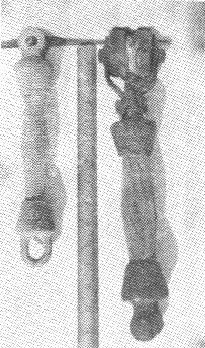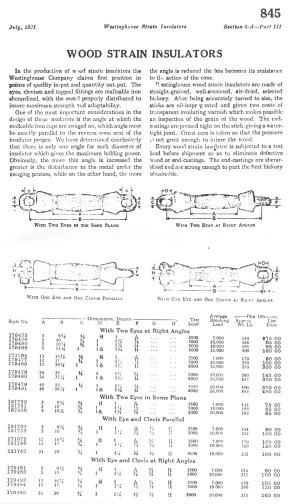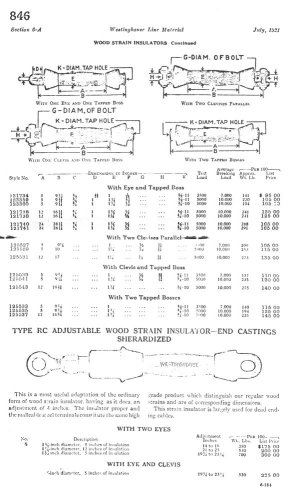Wood Strain Insulators
by Phil Klabel Peru, Illinois
Reprinted from "INSULATORS - Crown Jewels of the Wire", September 1971, page 23
Having seen a few Wood type Strain Insulators In recent issues of "Crown
Jewels", I'd like to pass on the Information I have on these.
Mr. J. F. Green, special sales representative for Westinghouse in Derry,
Pennsylvania was kind enough to Xerox two pages of their July 1921 catalog
showing their Wood Strains. I've enclosed a copy of his letter.
The photo enclosed shows a Clevis and white porcelain spool attached to one I
have. This must have been added on, as It's not shown In the catalog.
The Ohio Brass Company has also made this type of insulator. I saw many of
the Ohio Brass ones being used to put up an overhead trolley line at the
Illinois Railway Museum at Union, Illinois.

|
 |
Westinghouse Electric Corporation
Industry & Defense Products
333 West Third Street
Derry, Pennsylvania
15627
April 14, 1971 |
Mr. Phil Klabel
R. R. #1
Peru, Illinois 61354
Dear Mr. Klabel:
Your letter of April 10 to Westinghouse in Chicago has been forwarded to me.
I am attaching Xerox copies of Pages 845 and 846 taken from the Westinghouse
General Catalog of July, 1921. I believe these are the types of insulators to
which you refer.
I hope that this information will be helpful to you in identifying the sample
strain insulator which you described.
Yours truly,
J. F. Green
Special Sales Representative

Browse Image (143 kB) | Large
(766
kB) |
(Partial image text:)
845
July, 1921 Westinghouse Strain Insulators Section G-A--Part III
WOOD STRAIN INSULATORS
In the production of wood strain insulators the Westinghouse Company claims
first position in points of quality in- put and quantity out-put. The eyes,
clevises and tapped fittings are malleable iron sherardized, with the metal
properly distributed to insure maximum strength and adaptability.
One of the most important considerations in the design of these insulators is
the angle at which the malleable iron caps are swaged on, which angle must be
exactly parallel to the reverse cone seat of the insulator proper. We have
determined conclusively that there is only one angle for each diameter of
insulator which gives the maximum holding power. Obviously, the more this angle
is increased the greater is the disturbance to the metal under the swaging
process, while on the other hand, the more the angle is reduced the less becomes its resistance to the action of the
cone.
Westinghouse wood strain insulators are made of straight-grained,
well-seasoned, air-dried, selected hickory. After being accurately turned to
size, the sticks are oil-impregnated and given two coats of transparent
insulating varnish which makes possible an inspection of the grain of the wood.
The end castings are pressed tight on the stick, giving a watertight joint.
Great care is taken so that the pressure not great enough to injure the wood.
Every wood strain insulator is subjected to a test load before shipment so as
to eliminate defective wood or end- castings. The end-castings are sherardized
and are strong enough to part the best hickory obtainable.
|

Browse Image (116 kB) | Large
(606
kB)
|
